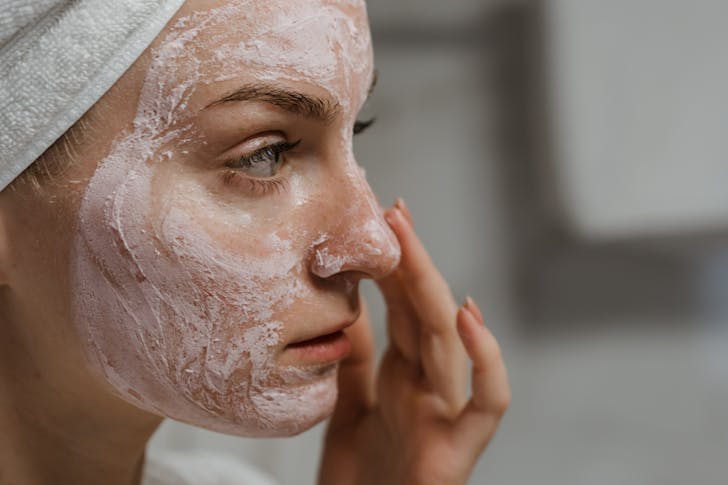
‘Splotchy Redness:’ What Is It & How to Overcome It?

Splotchy redness is a common skin issue that can leave you feeling self-conscious and frustrated. Whether caused by environmental factors, genetics, or skin conditions like rosacea, dealing with uneven red patches is a struggle many face.
The good news? There are skincare solutions that can help reduce and even eliminate this redness, allowing you to feel more confident in your own skin. Here are some of the best ways to soothe and manage splotchy redness:
Understand Splotchy Redness First
Splotchy redness happens when blood vessels close to the surface of your skin dilate, causing an uneven, flushed look. It can be triggered by a variety of factors like weather changes, stress, alcohol, or even spicy foods. For others, it is simply a part of living with sensitive skin or conditions like rosacea.

Olly / Pexels / Sure! It can be frustrating to deal with splotchy red skin. But finding the right skincare routine can make a world of difference. Your goal should be to soothe the skin, reduce inflammation, and protect it from further irritation.
So, the first step is identifying the right products and lifestyle adjustments that target the redness without aggravating your skin.
Use Gentle Cleansers to Calm Irritation
When dealing with splotchy redness, choosing the right cleanser is crucial. Harsh ingredients like sulfates can strip the skin of its natural oils, leaving it dry and more irritated. Instead, opt for a gentle, hydrating cleanser that helps balance your skin without causing flare-ups.
Look for cleansers with soothing ingredients like chamomile, aloe vera, or green tea. These natural anti-inflammatories work to calm your skin while cleansing away dirt and impurities. It is important to cleanse your face with lukewarm water rather than hot, as heat can further irritate the skin and exacerbate redness.
Try Moisturizers That Soothe and Protect
Hydration is essential when managing splotchy redness. Dry skin can make redness more pronounced, so keeping it well-moisturized is key. You will want to avoid heavy, greasy creams that might clog pores, as clogged pores can lead to even more irritation. Instead, look for lightweight, non-comedogenic moisturizers that hydrate without weighing down your skin.
Moisturizers containing ingredients like hyaluronic acid, niacinamide, and ceramides are excellent for replenishing moisture and strengthening the skin barrier. Niacinamide, in particular, is known for its ability to reduce redness and inflammation while promoting a healthy, glowing complexion.
Ideally, apply your moisturizer after cleansing to lock in hydration and protect your skin from environmental aggressors.
Go For Anti-Redness Serums and Treatments
For more targeted treatment of splotchy redness, anti-redness serums and treatments are worth exploring. These serums have calming ingredients that help reduce inflammation and soothe irritated skin.
One popular ingredient in anti-redness serums is azelaic acid. Azelaic acid works by reducing inflammation and swelling in the skin.

Polina / Pexels / To keep splotchy redness at bay, try more targeted anti-redness treatments and serums.
Another standout ingredient is licorice root extract. Known for its brightening and anti-inflammatory properties, licorice root can help reduce the appearance of redness and even out skin tone. Applying an anti-redness serum before moisturizing can amplify your skincare routine’s calming effects. This will help you achieve more even skin over time.
Avoiding Irritating Ingredients
One of the quickest ways to trigger a flare-up of splotchy redness is by using products with harsh or irritating ingredients. Alcohol, fragrances, and certain preservatives are common culprits that can inflame the skin and lead to more noticeable redness. Always check the ingredient list before trying out new products, and avoid those with potential irritants.
Instead, opt for products labeled as “fragrance-free” or “for sensitive skin.” Products with minimal ingredients tend to be less likely to cause irritation. Remember, the simpler the better – when it comes to sensitive skin.
More in Skin Care
-
`
How to Plan a Trip to Italy and Greece
Italy and Greece stand out as two of Europe’s premier travel destinations, each offering a unique blend of historical grandeur, stunning...
July 31, 2024 -
`
Are Makeup Wipes Bad for Your Skin?
In the quest for quick and convenient skincare, makeup wipes often seem like a miracle solution. However, if you’re wondering, Are...
July 26, 2024 -
`
How to Do Ab Workouts During Pregnancy?
Maintaining core strength is vital, but can you do ab workouts while pregnant? This question is common among expectant mothers eager...
July 19, 2024 -
`
5 Seamless Ways to Minimize BBL Scars
Undergoing a Brazilian Butt Lift (BBL) is an exciting decision for enhancing your body contour. However, BBL scars can be a...
July 12, 2024 -
`
Best Places for Birthday Party Fun for All Ages
Celebrating your birthday at an exciting venue can add that extra spark to your special day, whether you’re with family, friends,...
July 2, 2024 -
`
Skincare for Sensitive Skin: Top 6 Products to Try
Taking care of sensitive skin can be a challenge. With so many products on the market, finding the right ones that...
June 28, 2024 -
`
How to Build Muscles & Gain Mass After 50
Are you wondering how to build muscle mass after 50? You are not alone. Many people think that hitting the big...
June 20, 2024 -
`
How to Speed Up Your Nose Job Recovery Time
Undergoing a rhinoplasty is an exciting step towards a new appearance, but it comes with a recovery period that requires patience...
June 15, 2024 -
`
Best Tattoo Ideas for Women With Meaning
Are you on the hunt for tattoo ideas for women with meaning? Tattoos are more than just body art; they’re personal...
June 4, 2024















You must be logged in to post a comment Login